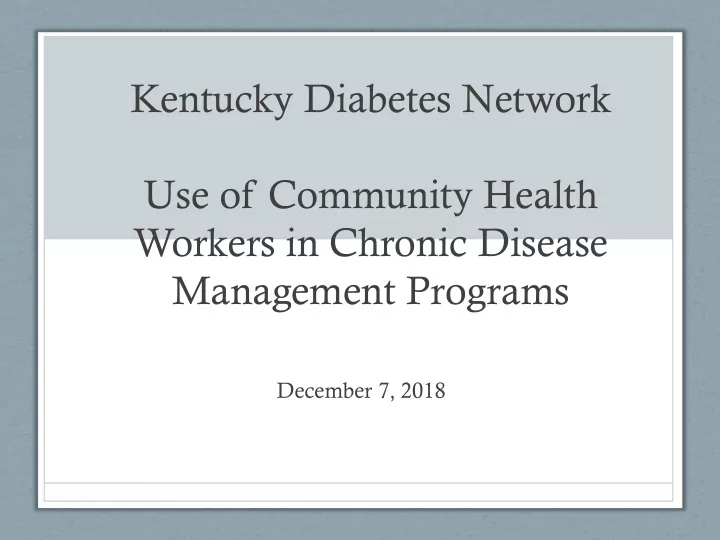

Kentucky Diabetes Network Use of Community Health Workers in Chronic Disease Management Programs December 7, 2018
Objectives for the Session • Provide a basic overview of a Community Health Worker (CHW) to include the APHA definition, basic core competencies, and scope of practice • Discuss the role of the CHW in five programs across the state. • Share “What’s Happening at the state level to advance the practice of Community Health Worker”: Curriculum, Certification and Evaluation. • Host an interactive question and answer session with KDN participants.
Community Health Worker (CHW) APHA Approved Definition • A CHW is a frontline health worker who is a trusted member of and has an unusually close understanding of the community served. This trusted relationship enables the worker to serve as a liaison between health & social services and the community to facilitate access to service and improve the quality and cultural competence of service delivery. A CHW also builds individual and community capacity by increasing health knowledge and self-sufficiency through a range of activities such as outreach, community education, informal counseling, social support and advocacy.
Core Competencies An Overview and Discussion Scope of Practice is Based on Core Competencies • Communication Public Health Concepts and Approaches • • Organizational and Community Outreach • Advocacy and Community Capacity Building • Care Coordination and System Navigation • Health Coaching • Documentation Reporting and Outcome Management Legal, Ethical and Professional Conduct •
One Urban Model – Partnering with the Acute Care Hospitals • Health Connections Program - a 90-day program with a focus on both the health coaching and social needs of the client. • An interdisciplinary team with an RN, LPN, Social Worker and two Community Health Workers. • Receives referrals from the acute care hospitals to support continuity of care into the community and medical home. The Community Health Worker takes the “warm handoff” • from the RN for health coaching and Social Worker to address and assist with the health coaching and social needs. • Two teams working in urban Louisville, Kentucky and supervised by the RN working in the home for up to 90 days.
A Place Based Model: Where You Live Impacts Your Health • One high utilizer program with a focus on 10 zip codes identified through a GIS mapping process. • Criteria for participation: • Resides in one of the 10 zip codes. • Payer source – Medicare, Medicaid or Uninsured • LACE score of 13 or greater. • Length of stay • Acuity • Comorbidities • Number of ED visits in the last six months.
Next Steps The CHW visits the client at the bedside prior to • discharge to review the program and obtain consent for participation. • The CHW contacts the client after discharge to schedule the home visit. CHW’s receive special training in home visits. • The RN and SW visit the client in the home to develop a patient centered care plan and intervention. The CHW receives the handoff and direction for health • coaching from the licensed team members.
CHW Role • Visits the client in the home to reinforce the care plan as a coach. • Works with the client to connect with community resources: food, housing, transportation, medication, supplies …… • Meets with the care team weekly to share updates. • Visits the client for up to 90 days until the client completes the program.
Four Pillars for Health Coaching The Eric Coleman Model • Medication Management • Making and Keeping MD Appointments • Maintaining a Personal Health Record • “Red Flag” recognition – calling the MD versus going to the ED.
Chronic Disease Coaching for Diabetes – Role, Training and Tools • Role of the CHW - Reinforcement of the Nursing Care Plan using the approved tools. • Training on Diabetes that includes health literate basic education, Types of Diabetes, Symptoms, Complications and Management. Reinforcement of education on diet, exercise and medication, use of • monitoring logs and other per the Care Plan. Access to resources – Medications, Accu-Check & Strips. • • Health Literate approved training tools. • Referrals to community Diabetes Education Programs
Measuring Success • Triple Aim of Health – Better Health, Better Patient Experience and Lower per Capita Cost • Reduction of avoidable hospital readmissions and use of the Emergency Department. • Improved depression scores, self-efficacy and patient experience. • Lower per Capita Cost – Calculating the ROI
Thank You • Thanks to all for your attendance. • If you have any follow-up questions or needs contact: • Bev Beckman at 502-292-9519 or bevbeckman1@gmail.com
Recommend
More recommend